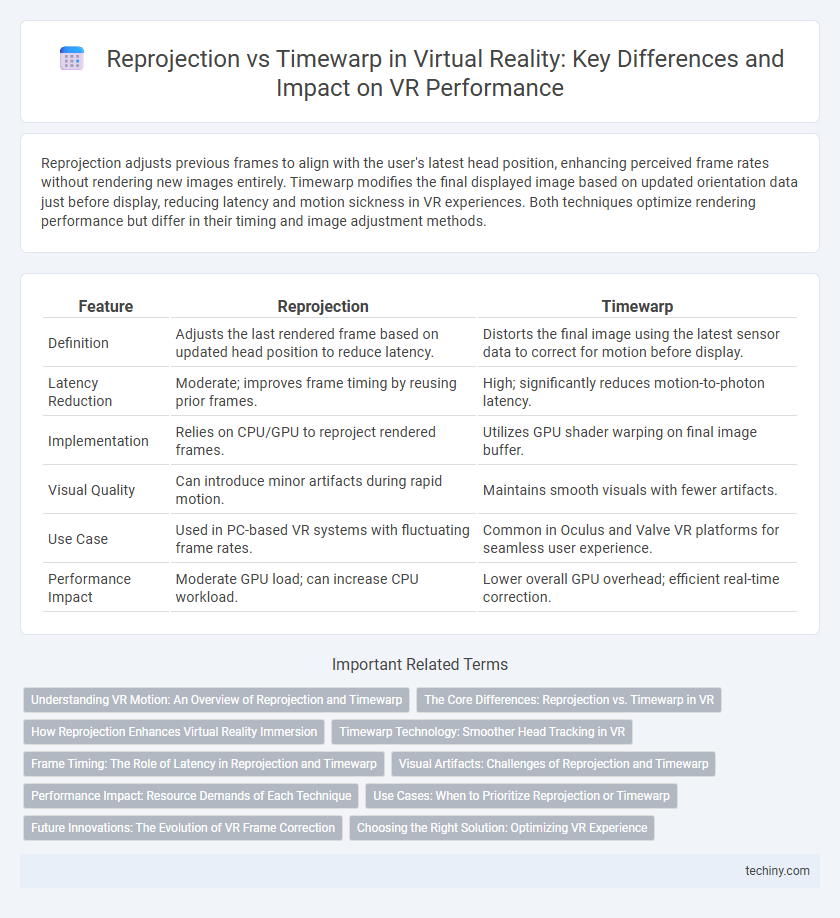Reprojection adjusts previous frames to align with the user's latest head position, enhancing perceived frame rates without rendering new images entirely. Timewarp modifies the final displayed image based on updated orientation data just before display, reducing latency and motion sickness in VR experiences. Both techniques optimize rendering performance but differ in their timing and image adjustment methods.
Table of Comparison
| Feature | Reprojection | Timewarp |
|---|---|---|
| Definition | Adjusts the last rendered frame based on updated head position to reduce latency. | Distorts the final image using the latest sensor data to correct for motion before display. |
| Latency Reduction | Moderate; improves frame timing by reusing prior frames. | High; significantly reduces motion-to-photon latency. |
| Implementation | Relies on CPU/GPU to reproject rendered frames. | Utilizes GPU shader warping on final image buffer. |
| Visual Quality | Can introduce minor artifacts during rapid motion. | Maintains smooth visuals with fewer artifacts. |
| Use Case | Used in PC-based VR systems with fluctuating frame rates. | Common in Oculus and Valve VR platforms for seamless user experience. |
| Performance Impact | Moderate GPU load; can increase CPU workload. | Lower overall GPU overhead; efficient real-time correction. |
Understanding VR Motion: An Overview of Reprojection and Timewarp
Reprojection and timewarp are essential techniques in virtual reality to maintain visual stability and reduce motion sickness by compensating for latency and motion changes between frames. Reprojection reuses previous frames by shifting pixels based on head movement, while timewarp adjusts the rendered image in real-time just before display to align with the latest user pose data. Understanding these processes helps optimize VR experiences by ensuring smooth, immersive motion and minimizing perceptual artifacts during rapid head movements.
The Core Differences: Reprojection vs. Timewarp in VR
Reprojection and timewarp are critical techniques in VR to maintain smooth visuals by compensating for latency and motion changes. Reprojection generates intermediate frames by reusing previous frame data to reduce judder when frame rates dip below the display's refresh rate, while timewarp dynamically warps the final rendered image based on the latest head tracking information to minimize perceived latency. The core difference lies in reprojection's method of estimating missing frames versus timewarp's real-time transformation of the rendered frame to align perfectly with current user movements.
How Reprojection Enhances Virtual Reality Immersion
Reprojection enhances virtual reality immersion by smoothing frame transitions and reducing latency, which minimizes motion sickness and maintains visual consistency during rapid head movements. Unlike timewarp, which adjusts the final image based on predicted head position, reprojection recalculates intermediate frames to provide more accurate and fluid motion representation. This method improves user presence and realism by delivering higher frame rates and reducing artifacts in VR environments.
Timewarp Technology: Smoother Head Tracking in VR
Timewarp technology significantly enhances VR experiences by reducing latency and smoothing head tracking movements, resulting in a more immersive and comfortable user environment. Unlike traditional reprojection methods that rely on frame delay correction, timewarp actively adjusts rendered frames based on the latest head position data, minimizing motion sickness. This real-time frame adjustment ensures fluid motion and reduces visual artifacts, setting a new standard for VR responsiveness.
Frame Timing: The Role of Latency in Reprojection and Timewarp
Frame timing critically influences latency in virtual reality, affecting reprojection and timewarp effectiveness. Reprojection interpolates previous frames to reduce perceived latency, while timewarp adjusts rendered images based on the latest head pose. Optimizing latency ensures smoother frame transitions, enhancing user immersion and minimizing motion sickness in VR environments.
Visual Artifacts: Challenges of Reprojection and Timewarp
Reprojection techniques often introduce ghosting and blurring artifacts due to inaccurate motion estimation, while timewarp can cause image distortion and warping around the edges of the frame. Both methods struggle with rapid head movements, leading to mismatched frames and visual latency that degrade immersion. Effective mitigation requires advanced predictive algorithms and high refresh rate displays to minimize these visual artifacts in virtual reality environments.
Performance Impact: Resource Demands of Each Technique
Reprojection techniques use motion vectors to adjust frames, resulting in moderate GPU load and improved frame rates on mid-range VR hardware. Timewarp relies on low-latency sensor data to reproject the final image with minimal computational overhead, significantly reducing input lag and conserving processing resources. Choosing between reprojection and timewarp depends on the VR system's hardware capabilities and desired balance between visual fidelity and smooth performance.
Use Cases: When to Prioritize Reprojection or Timewarp
Reprojection is ideal for scenarios with moderate frame drops, such as fast-paced VR games, where maintaining spatial stability and reducing motion sickness is critical. Timewarp excels in ultra-low latency environments like VR simulations or training applications, correcting predicted head movement between frames to ensure smooth user experience. Prioritize reprojection when visual fidelity needs preservation under fluctuating performance, and timewarp when responsiveness and minimizing latency are paramount.
Future Innovations: The Evolution of VR Frame Correction
Future innovations in VR frame correction are pushing beyond traditional reprojection and timewarp techniques to enhance visual stability and reduce motion sickness. Advanced methods like asynchronous reprojection combined with machine learning algorithms predict user movements with greater accuracy, enabling smoother frame transitions. Emerging technologies such as foveated rendering and AI-driven frame interpolation promise to optimize performance while maintaining immersive and responsive VR experiences.
Choosing the Right Solution: Optimizing VR Experience
Reprojection and timewarp are critical techniques to reduce latency and maintain smooth frame rates in virtual reality, with reprojection predicting intermediate frames based on previous data and timewarp adjusting the image using latest head position. Selecting the right solution depends on balancing hardware capabilities and user comfort, as reprojection suits lower-end systems while timewarp excels in high-performance setups to minimize motion sickness. Optimizing VR experience involves leveraging timewarp for real-time image correction and reprojection for consistent frame pacing under resource constraints.
reprojection vs timewarp Infographic

 techiny.com
techiny.com